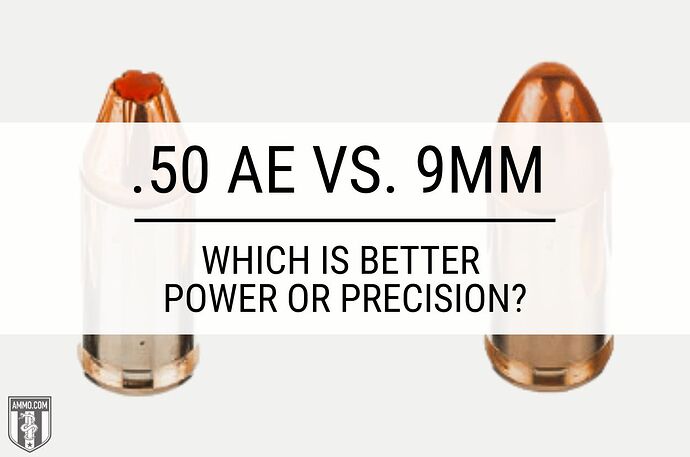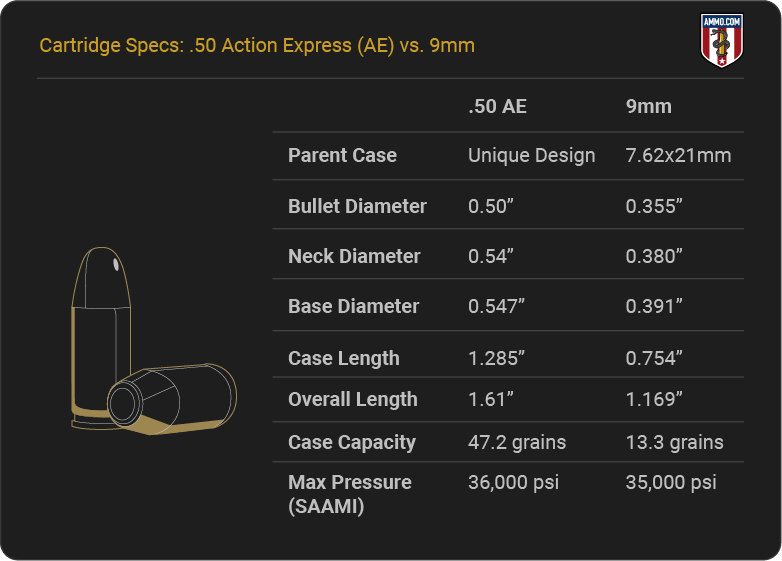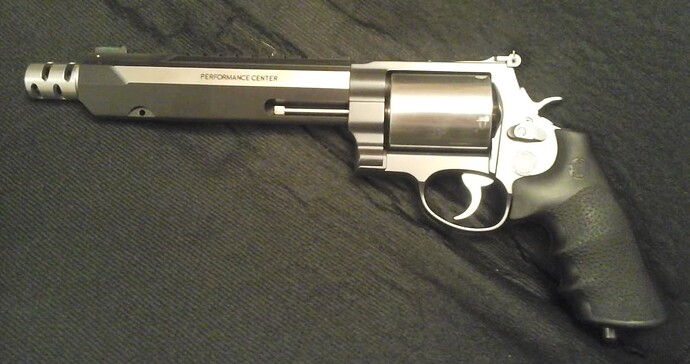50 AE vs. 9mm is a comparison between vastly different pistol cartridges. One is perfect for concealed carriers, and the other is a must for big game hunters.
Any round has its unique advantages and disadvantages. As you continue reading, you’ll discover the relative pros and cons of these two handgun cartridges in everyday scenarios. We’ll track which is better in certain situations and tally the score at the end of the article to determine a winner.
Let’s go!
.50 AE Compared To 9mm
The .50 Action Express is one of the most powerful handgun cartridges in production, with some .50 AE ammo generating more than 1,660 ft-lbs of muzzle energy. The Magnum Research Desert Eagle 50 AE is one of Hollywood’s favorite guns, regularly seen in movies such as Snatch and The Matrix. The .50 AE is also a popular choice for big game hunting worldwide.
The 9mm Luger is one of the most popular concealed carry choices because of its low recoil and high magazine capacity. It’s chambered in pistols (such as the Glock 17), revolvers such as the Ruger LCR, and carbines such as the Smith & Wesson M&P FPC.
We’ll begin our comparison with each cartridge’s technical specifications and then explore real-world scenarios to help you determine which cartridge is better.
Technical Specs: 9mm vs. .50 AE
When we compare these cartridges side by side, the differences are clearly visible. Shooters will have no problem distinguishing between the 9mm Luger (1.169 inches in total length) and .50 Action Express (1.610 inches in total length).
For starters, the .50 AE is loaded with a .50 caliber bullet (0.5 inches in diameter), which is even larger than 44 Magnum and 454 Casull bullets. The 9mm fires a much smaller projectile (0.355 inches), which is narrower than a 40 S&W bullet. Its larger diameter also means the .50 AE has a much heavier bullet weight (300 grain bullets are the most common) than the 9mm (165 grain is one of the heaviest).
Just because the .50 AE utilizes a heavier projectile doesn’t mean it has a slow muzzle velocity; the opposite is true. Thanks to its high case capacity (47.2 grains), it can hold more propellant to launch the bullet at a high velocity (1,450+ fps). The 9mm only has a case capacity of 13.3 grains, and conventional standard pressure factory ammo maxes out muzzle velocities at around 1,300 fps.
The most surprising similarity for me was the maximum pressure. The .50 AE maxes out at 36,000 psi, and the 9mm maxes at 35,000 psi.
Before you purchase either cartridge, let’s examine how these differences and similarities affect recoil, accuracy, stopping power, overall cost, and other significant factors.
What Is the Recoil Like on a .50 AE Compared to a 9mm Pistol?
Recoil is an essential consideration. A round with lots of recoil is more challenging to control, slows your follow-up shot rate, and causes flinching to become more of an issue.
Free recoil is determined by muzzle velocity (fps), propellant weight, bullet weight, and firearm weight. Felt recoil differs from shooter to shooter and often depends on the firearm, stance, and ammo. Felt recoil is subjective. I will judge based on free recoil because it’s objective.
It’s impossible to provide an “apples to apples” comparison of both cartridges because of the drastic differences in gun weight, bullet weight, and propellant load. However, I’ll do my best to make everything as fair and straightforward as possible.
We’ll use a Magnum Research Desert Eagle .50 Action Express, which weighs 4.8 pounds and is loaded with an Underwood Ammo 325 grain jacketed hollow point (JHP) cartridge with a muzzle velocity of 1,475 fps.
The .50 AE will have around 27 ft-lbs of recoil in the given scenario. That’s a lot for a handgun.
For the 9mm, we’ll use the Glock 45, which weighs 2 pounds and is loaded with Winchester 115 grain full metal jacket (FMJ) ammo with a muzzle velocity of 1,190 fps. In this scenario, the 9mm will only have around 4 ft-lbs of free recoil.
The 9mm easily wins this section as the .50 AE has abundantly more recoil than the 9mm.
Continue reading 50 AE vs. 9mm: Power or Precision? on Ammo.com



